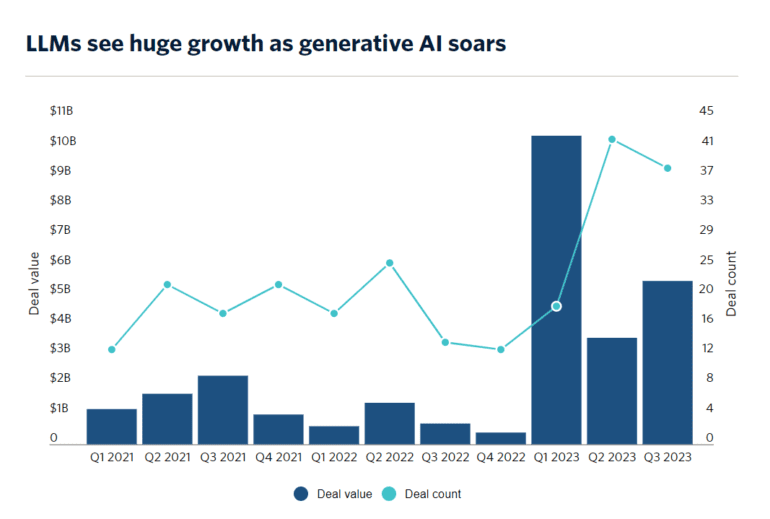TL;DR:
- Startups are adopting open-source large language models (LLMs) with VC support to enhance capital efficiency.
- Open-source LLMs pose a significant challenge to proprietary models, reducing costs and lowering entry barriers.
- Major players like Meta and Hugging Face offer free, customizable models for research and commercial use.
- LLM startups have attracted substantial investments in 2023, including support from tech giants like Microsoft and Amazon.
- Open-source models can lead to substantial cost savings, putting pressure on proprietary models’ pricing.
- Investors are turning to open-source models due to oversaturation in the generative AI market.
- While open-source models offer cost benefits, they may lag in quality compared to proprietary counterparts.
Main AI News:
The landscape of generative AI is undergoing a transformation, and it’s not the usual competition from tech giants that’s causing the ripples. Startups, driven by the vision of deploying capital more efficiently, are increasingly turning to open-source versions of large language models (LLMs). This strategic shift is endorsed by venture capitalists (VCs) who see an opportunity to reduce costs, thereby disrupting the hegemony of LLM providers and lowering barriers to entry.
Large language models, commonly referred to as LLMs, have proven to be a lucrative venture for startups that offer access to their cutting-edge technology. While proprietary models like OpenAI’s ChatGPT or Anthropic’s Claude have traditionally dominated the field, a burgeoning number of startups are now betting big on an open-source future.
Wei Lien Dang, a general partner at Unusual Ventures, remarked on the transformation, saying, “If you went back nine months, you did not see strong open alternatives to OpenAI and some of the leading proprietary solutions. There’s been this significant proliferation.”
Open-source models pose the most formidable challenge yet to proprietary LLM providers, signaling a major shift since generative AI’s initial surge in popularity last year. Offerings like Meta’s Llama 2, Technology Innovation Institute’s Falcon 180B, and others are not only free for commercial and research use but also offer greater customization and deployment flexibility. The public, too, has access to a vast array of open-source options, with platforms like Hugging Face, renowned for its repository of open-source models, securing substantial funding, such as their recent $235 million Series D led by Salesforce Ventures in August.
Venturing into LLMs has historically been a capital-intensive endeavor due to the substantial computational costs associated with them. Startups licensing proprietary models like OpenAI’s ChatGPT often face exorbitant monthly bills, running into thousands or even tens of thousands of dollars. Remarkably, 2023 has seen unprecedented investments in LLM startups, surpassing all previous years combined, as indicated by PitchBook data. Much of this capital influx has been driven by industry giants, with Microsoft investing $10 billion in OpenAI in January, Amazon committing $4 billion to Anthropic in September, and Inflection securing a $1.3 billion Series B in June, co-led by Nvidia.
Investors are increasingly drawn to open-source models for their ability to provide startups with capital efficiency and flexibility. Wei Lien Dang noted, “From a capital perspective, it becomes more accessible for a great number of companies. It allows for capital to be more efficient.”
The viability of open-source models as a threat to incumbents like OpenAI and Google became evident in May when a leaked internal memo from a Google engineer referred to the open-source community as “a third faction [that] has been quietly eating our lunch.“
James Currier, a general partner at NFX, emphasized the significant cost savings associated with this shift. He cited an example of one of his portfolio companies, which reduced its monthly expenditure from $150,000 to a mere $4,000 by transitioning to an open-source option.
“People’s minds are catching up to what the technology can do,” Currier said. “Engineers are more free to play and don’t feel blocked by the price tags of a year ago.“
Additionally, Currier pointed out that this trend has the potential to exert downward pressure on the prices of proprietary models like ChatGPT, essentially reshaping the market landscape.
Some investors are embracing open-source models simply because the sheer enthusiasm generated by VCs in the generative AI space has led to an oversaturation of LLM options. Fabrice Grinda, founding partner at FJ Labs, described the situation as reaching a fever pitch. “There’s infinite money going in at reasonably insane valuations in many companies that are undifferentiated,” Grinda said. “It’s a lot of chasing the same deals.“
While open-source models offer cost advantages, it’s essential to acknowledge that they may not match the quality of proprietary models like ChatGPT. This disparity arises from factors such as smaller data inputs, reduced security, and the absence of regular updates from the publisher. Wei Lien Dang estimated that open-source models lag approximately nine months behind the improvements and enhancements seen in OpenAI’s latest model, GPT-4. Nevertheless, James Currier contended that, depending on the specific use case, open-source models often prove sufficient.
In his words, “The VW Bug still works on the road. It’s an older technology, but you still see a bunch of Bugs driving around California.”
Conclusion:
The rise of open-source large language models fueled by VC backing is reshaping the generative AI landscape. Startups leveraging open-source models are poised to disrupt the dominance of proprietary models, offering cost-efficiency and flexibility. This trend is attracting substantial investment and driving down prices, impacting the market dynamics and leading to increased competition in the generative AI sector.

